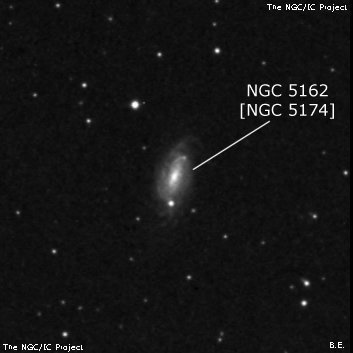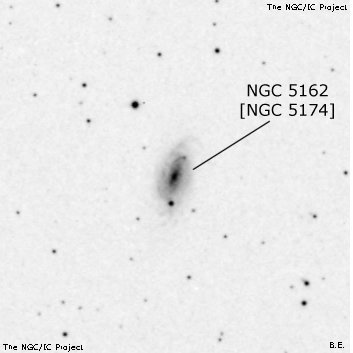NGC/IC Project Restoration Effort
(This is a very very beta version)
NGC5174


Basic Information
Location and Magnitude
Right Ascension: 13:29:25.9
Declination: +11:0:28
Constellation: VIR
Visual Magnitude: 13.0
Historic Information
Discoverer: Herschel W.
Year of discovery: 1784
Discovery aperture: 18.7
Observational
Summary description: vF, pL, D neb, close
Sub-type: Sc
Corwin's Notes
=====
NGC 5174 = NGC 5162 (which see) and NGC 5175 are a pair of objects discovered
by WH: "Two, mistaken for one; but 240 shewed (sic) them both. cL, vF."
JH observed these twice; his description from his first observation (Sweep
120) is correct: "eF, E; involves a star at the south end, and has a star 6
mag 15 arcmin south and a few seconds preceding." His second observation in
(Sweep 242) is somewhat more in accord with his father's: "vF; two close
together, or one E nearly in the meridian. A star 11 mag north."
Using LdR's 72-inch, Dreyer also "Found only one neb, vF, vS, stellar, no
other neb found. A * 12m about 4 arcmin nf. The ground appeared milky round
about." He goes on to comment, "h seems also to have seen but one neb, viz,
1612, his '* 11m n' may be my * 12 m ..."
Yet CGCG called this a "double" galaxy, and has managed to confuse a lot of
modern observers. There is, of course, only one galaxy here, with two stars
superposed on the arms north and south of the nucleus.
It is possible, I suppose, that WH split the galaxy as happened with e.g. NGC
2442 and NGC 2443, and NGC 2903 and NGC 2905. This gives us two
possibilities: The second nebula might be the part of the galaxy
north-northwest of the nucleus more or less centered on the faint star there
(in my previous note on this galaxy, I had mistakenly called this star an HII
region. It is clearly a star in the SDSS image). This northern star was
apparently seen only by Swift (see his description under the note for NGC
5162). The second possibility is the considerably brighter southern
superposed star with the surrounding arm(s). I think that this is the more
likely candidate for NGC 5175. I give the positions for both stars in the
big table.
Steve's Notes
=====
NGC 5174
17.5" (5/27/95): fairly faint, moderately large, elongated 5:2 NNW-SSE, 2.5'x1.0', broad concentration to a brighter core. A mag 14 star [NGC 5175] is superimposed on the south end 45" from the center. A mag 12 star is 2.3' NNE. Brightest in a group of NGC galaxies with most members about 30' N. Located 11' NNE of 71 Virginis (V = 5.7).



